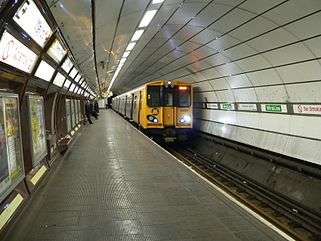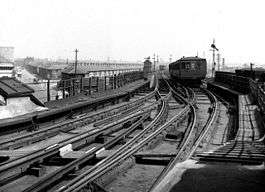Rapid transit in the United Kingdom
Rapid transit in the United Kingdom consists of five systems in four cities: the London Underground and Docklands Light Railway, Tyne and Wear Metro, the Glasgow Subway and Merseyrail in the Liverpool City Region. Rapid transit has also been proposed in other U.K. cities including Manchester, Birmingham, Bristol, and Cambridge.
History
.jpg) London Underground trains at Baker Street station marking 150 years since the foundation of the Metropolitan Railway, the world's oldest underground metro system
London Underground trains at Baker Street station marking 150 years since the foundation of the Metropolitan Railway, the world's oldest underground metro system A Merseyrail train at Liverpool Central. The service is a descendant of the Mersey Railway, which was opened in 1886.
A Merseyrail train at Liverpool Central. The service is a descendant of the Mersey Railway, which was opened in 1886. The Liverpool Overhead Railway, which operated from 1893-1956
The Liverpool Overhead Railway, which operated from 1893-1956 A train at Kinning Park on the Glasgow Subway, the world's third-oldest underground metro system
A train at Kinning Park on the Glasgow Subway, the world's third-oldest underground metro system The Tyne and Wear Metro was opened between 1980 and 1984, using converted former railway lines, linked with new tunnel infrastructure.
The Tyne and Wear Metro was opened between 1980 and 1984, using converted former railway lines, linked with new tunnel infrastructure.- The Docklands Light Railway (DLR) was opened in 1987 is currently the UK's only automated metro system
The United Kingdom is the birthplace of rapid transit, with London and Liverpool hosting the world's first and second urban rail transit and Glasgow the fourth. From 1893 to 1956 the Liverpool Overhead Railway was the only elevated rapid transit in the country, however fell into disuse being demolished in 1957. In the 20th and 21st century the United Kingdom has chosen to not prioritise investment in rapid transit schemes; instead cities like Manchester, Sheffield, and Edinburgh have opted for trams.
List of systems
| City | System | Start of operations | System length | Lines[lower-alpha 1] | Stations[lower-alpha 2] | Voltage | Notes |
|---|---|---|---|---|---|---|---|
| London | London Underground | 10 January 1863 | 402 km | 11 | 270 | 630 V DC fourth rail | The oldest rapid transit system, incorporating the world's first underground railway. |
| London | Docklands Light Railway | 31 August 1987 | 34 km | 7 (routes) | 45 | 750 V DC third rail | An automated light metro system opened in 1987 to serve the redeveloped Docklands area of London. |
| Liverpool | Merseyrail | 1886 (Mersey Railway) | 121 km (official lines) | 2 official (and one unofficial line) | 68 | third-rail 750 V DC | A rapid transit rail network, in the Liverpool City Region, England. The network has 68 stations running on 75 miles of route, of which 6.5 miles are underground, forming one of the most heavily used railway networks in the UK outside London. |
| Tyne and Wear | Tyne and Wear Metro | 11 August 1980 | 74.5 km | 2 | 60 | 1500 V DC OLE | A rapid transit and light rail system in North East England, serving Newcastle upon Tyne, Gateshead, South Tyneside, North Tyneside and Sunderland in the Tyne and Wear region. |
| Glasgow | Glasgow Subway | 14 December 1896 | 10.5 km | 1 | 15 | 600 V DC third rail | An underground metro line in Glasgow. It is the third-oldest underground metro system in the world after the London Underground and the Budapest Metro, and the only heavy rail underground metro system in the British Isles outside London. |
The following are usually referred to as commuter rail systems, but possess aspects of rapid transit:
| City | System | Start of operations | System length | Lines[lower-alpha 3] | Stations[lower-alpha 4] | Voltage | Notes |
|---|---|---|---|---|---|---|---|
| London | London Overground | 11 November 2007 | 123.6 km (official lines) | 8 | 112 | third-rail 750 V DC and 25 kV 50 Hz AC (overhead line) | A suburban rail network in the United Kingdom, serving a large part of Greater London and parts of Hertfordshire. Contains the East London line, a former London Underground line. |
| London | Crossrail (first phase) | 2019? | 136 km | 1 | 40 | 25 kV 50 Hz AC (Overhead line) | A railway line under construction in London and its environs, providing a new east-west route across Greater London. The aim is to provide a high-frequency commuter/suburban passenger service that will link parts of Berkshire and Buckinghamshire, via central London, to Essex and South East London, relieving the pressure on other railway services. |
| London | Crossrail (second phase) | To be confirmed | To be confirmed | 1 | To be confirmed | 25 kV 50 Hz AC (Overhead line) | A proposed rail route in South East England, running from nine stations in Surrey to three in Hertfordshire providing a new rail link across London on the Crossrail network. |
Defunct systems
Cancelled systems
Proposed systems
- Bristol Underground
- North and West London Light Railway
- Taunton metro rail
- West London Orbital
- Cambridge Metro[1]
- Glasgow Metro (light rail)
- South Hampshire Rapid Transit
- Cardiff Metro
See also
- Urban rail in the United Kingdom
- List of modern tramway and light rail systems in the United Kingdom
- List of guided busways and BRT systems in the United Kingdom
Notes
- Indicates lines that are in operation for operational systems, lines that are under construction for under construction systems and proposed lines for proposed systems.
- Indicates stations that are in operation for operational systems, stations that are under construction for under construction systems and proposed stations for proposed systems.
- Indicates lines that are in operation for operational systems, lines that are under construction for under construction systems and proposed lines for proposed systems.
- Indicates stations that are in operation for operational systems, stations that are under construction for under construction systems and proposed stations for proposed systems.
